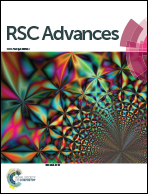Synthesis of Sn(1−x)Fex@FeySn(1−y)Oz nanohybrids via a simple programmed microfluidic process
Abstract
Core–shell Sn(1−x)Fex@FeySn(1−y)Oz nanohybrids are synthesized via a simple programmed microfluidic process. Characterization by high resolution transmission electron microscopy, energy dispersion X-ray spectroscopy and X-ray diffraction indicates that their sizes, shapes, compositions and crystal structures can be conveniently tuned by reaction temperatures. Different from the orientated growth to rod shaped Sn(1−x)Fex@FeySn(1−y)Oz nanorods (x ≪ 0.1, y < 0.5) with tin-rich crystalline cores and amorphous shells mixing with tiny Fe@FeOx nanoparticles at a low reaction temperature (e.g., 30 °C), the Sn(1−x)Fex@FeySn(1−y)Oz nanospheres (x < 0.5, 0.5 < y < 1) with crystalline tin-rich FeSn alloy cores and surface oxidized tin ferrite shells can be formed at an elevated reaction temperature (e.g., 90 °C). A blue-shift was found in the photoluminescence spectrum due to the existence of Fe in Sn(1−x)Fex@FeySn(1−y)Oz nanospheres compared with those Sn@SnO2 nanohybrids. The superparamagnetic property observed in the nanospheres can be attributed to the SnFe alloy cores and amorphous tin ferrite shells. As to the portion of Fe doping of Sn@SnO2 nanorods mixed with Fe@FeOx nanoparticles formed at 30 °C, they exhibit paramagnetic properties with increased saturated magnetic fields.


 Please wait while we load your content...
Please wait while we load your content...